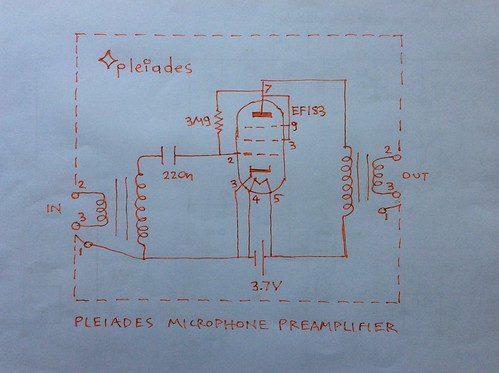At your risk. Attention to all safety precautions is important for safety. Also batteries should always be connected in series with a suitable fuse in series to protect from short circuit or fire hazard.
The Pleiades V6 amplifier is used. Cc is 22nF. No input transformer. Head instead of output transformer. Rag is 1.5MΩ.

The sound so far does not rock the earth. But keeps improving. The sense is that it is worth continuing. It is a warm and natural sound.
Today it's first time a Pleiades re-recording is made in stereo by connecting each channel of 1/4 track cassette head to an anode.
Recording signal path:
Is it OK if I call you mine? 06 track from original Fame soundtrack on CD - Sony portable CD player line out - 2x Pleiades V6, EF183, Rag=1.5MΩ - side A, 2 tracks of Tascam Porta 03 head - TDK SAX type II cassette
Playback signal path:
TDK SAX cassette - Sony TC-D5 Pro II - Sennheiser HD580
The head is connected between Vb battery (+) and anode ie instead of an output transformer or impedance coupling inductor.
The following tests:
1. Feeding heads with 3.6V, ie Vb=3.6V.
Interesting first time stereo sound with this setup. Somewhat lower output. Somewhat more treble. Somewhat more distortion. Nice sound. Hiss sounds thick like playing a vinyl record. Head is under biased at around 250μA. When music stops, the thick hiss can be heard with some HF components.
2. Just one EF183 electron tube feeding both head coils for 1/2 track mono. This experiment is a preliminary to using all 4 tracks simultaneously for close to 2'track stereo on cassette. Vb=7.2V.
Better sound? Maybe. Less distortion? Yes. Bias for each coil should be 500μA. More treble than expected as the 2 head inductors are in parallel making a half inductance total, see RL filters or Pleiades filters. Treble Less or not as nice as test 1. More tape modulation, approx +3VU.
3. Back to stereo with 2 electron tubes and Vb=5.5V. At this stage 7.2 volt can't be used as with 1.5MΩ from anode to grid anode current is 1000μA. On previous test each coil shared 500μA. 1000μA completely saturates tape.
Nice big and thick sound. Still lacking treble but not in an objectionable way. Some harmonic distortion. Playback VU meters hit at times +3VU and more. Thick hiss noise heard only when song had been paused while recording. Why? Does brain ignores thick hiss while the song is being played? Or does bias noise decrease as the music signal rides above and below it?
Funnily enough this hiss cannot be heard while music is playing.
This may be good news.
But the song does not sound bright yet as there is no gap loss recording amplifier treble boost for compensation.
When cathode heaters are disconnected while recording treble increases. This must be because of 2 reasons. DC bias decreases. Anode internal resistance increases so the head is fed more correctly with constant current with respect to frequency.
It is funny hiss when recording had been paused sounds like lifting the tone arm while music is playing on record.
How to move forward?
Sticking with around 250μA-400μA tape bias ie plate (anode) current but increasing plate supply voltage. Therefore the pull up bias resistor has to be increased for given supply voltage until anode current reduces to 400μA. Would this create constant current conditions up to a higher frequency? Ie increasing of available recording voltage for high frequencies.
It is interesting recording with just one electron tube per channel on magnetic tape.
How would it sound at 7.5ios on cassette or 7.5ios or high on reel to reel 1/4in?
No comments:
Post a Comment